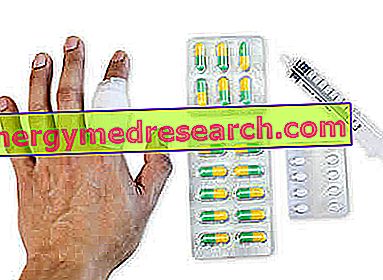Definition
The snap finger - also known as the stenosing tenosynovitis of the finger flexors - is a disorder characterized by the inflammation of the synovial sheath that surrounds the tendon of the fingers.
The snap finger strikes above all - but not only - women. This disease tends to manifest itself above all in the predominant hand and can also affect several fingers simultaneously.
Causes
As mentioned, the snap finger is caused by the inflammation of the synovial sheath that surrounds the tendon of the finger affected by the disorder. The inflammation produces a thickening and a narrowing of the synovial sheath, thus hindering the sliding of the tendon inside the same. Because of this phenomenon, when one tries to spread the finger from a closed or gripping position, it remains bent, and then extends with a "snap" movement (hence the name of the pathology).
The main factors that can increase the risk of the onset of the snap finger are trauma to the hand, the presence of rheumatic diseases, diabetes, hypothyroidism and some types of infection. Furthermore, subjects who for any reason have to perform repeated gripping movements are more susceptible to the onset of the disease.
Symptoms
In addition to the typical "jerky" movement of the finger affected by the inflammation, the symptoms that can occur during this pathology are swelling and joint pain, pain in the hand and wrist, joint stiffness and formation of a nodule at the base of the affected finger .
In more serious cases, moreover, the finger may not be able to complete the extension, thus remaining in a bent position.
Information on Finger Snap - Drugs and Finger Finger Care are not intended to replace the direct relationship between health professional and patient. Always consult your doctor and / or specialist before taking Dito a Scatto - Drugs and Finger Care.
drugs
The drugs that are used for treating the finger are mainly non-steroidal anti-inflammatory drugs (NSAIDs) and corticosteroids. The type of therapy to be undertaken, however, may vary depending on the severity of the clinical picture presented by the patients.
In the milder cases of finger snap, in fact, you can proceed with non-pharmacological treatments, such as splinting of the finger and carrying out specific exercises, so as to favor the mobility of the affected finger. Obviously, it is essential to keep the finger at rest and avoid frequent gripping movements.
For the more serious cases, on the other hand, it may be necessary to use anti-inflammatory and analgesic drugs to burn the synovial sheath and to reduce the pain caused by the disease.
In cases where the treatments just mentioned are not effective, it may be necessary to have surgery.
Following surgery, a therapy based on anti-inflammatory drugs and a physiotherapy course can be prescribed to restore the movement of the joint.

NSAIDs
Non-steroidal anti-inflammatory drugs can be used in the treatment of finger snap thanks to their anti-inflammatory and analgesic properties, so as to reduce the inflammation of the synovial sheath and to alleviate the pain caused by the disease.
The following are the active ingredients most commonly used in the treatment of finger snap and some indications will be given on the doses usually used in therapy. However, the exact dosage of the drug must be established by the doctor according to the severity of the inflammation and the patient's condition, therefore, it is essential to always follow the indications provided by it.
- Ketoprofen (Arthosylene ®, Orudis ®, Oki ®, Fastum gel ®, Flexen "Retard ® ®, Ketodol ®): ketoprofen is available in different pharmaceutical formulations suitable for different routes of administration (oral, dermal, rectal and parenteral). When taken orally in the treatment of finger snap, the dose of active ingredient usually used is 150-200 mg a day, to be taken in 2-3 divided doses, preferably after meals. It is very important not to exceed the maximum dose of 200 mg a day.
When using pharmaceutical formulations for cutaneous use based on ketoprofen, it is advisable to apply the product in the affected area 1-3 times a day, or according to a medical prescription. It is important to remember that - to avoid the onset of photosensitivity reactions - the part treated with ketoprofen for cutaneous use must not be exposed to sunlight and UV rays, both during treatment and for a period of at least two weeks from the end of the same.
- Ibuprofen (Brufen ®, Moment ®, Nurofen ®, Arfen ®, Actigrip fever and pain ®, Vicks fever and pain ®): also ibuprofen is available in different pharmaceutical formulations suitable for different routes of administration. When administered orally in the treatment of snap finger, the dose of ibuprofen used may vary from patient to patient and must be established by the doctor. However, the maximum dose of 1, 200 to 1, 800 mg of active ingredient per day should not be exceeded.
- Naproxen (Momendol ®, Synflex ®, Xenar ®): when naproxen is administered orally, the usual dose is 500-1, 000 mg of drug per day, to be taken in divided doses every 12 hours. When using naproxen-based gel or cream, on the other hand, it is recommended to perform two applications a day directly on the affected area.
Corticosteroids
Corticosteroid-based therapy for treating finger snaps involves local treatment by infiltrating them at the tendon membrane. This therapeutic approach tends to be more effective if performed shortly after the onset of the first symptoms of the disease.
In some cases, corticosteroids used for treating finger snap are available in pharmaceutical formulations in association with local anesthetics (such as, for example, lidocaine).
Infiltration of corticosteroids is a delicate operation and must be performed by specialized personnel, as there is a risk of causing damage and rupture of the tendon.
Among the corticosteroids used in curing the finger, we recall:
- Methylprednisolone (Depo-Medrol ®): methylprednisolone is used in the treatment of snap finger in association with lidocaine. The dose of drug usually used varies from 4 mg to 80 mg, depending on the severity of the disease.
- Dexamethasone (Soldesam ®): the dose of dexamethasone usually used for treating the finger is 0.4-1 mg, depending on the severity of the disease.
- Triamcinolone (Kenacort ®): the usual starting dose of triamcinolone is 2.5-5 mg. If deemed necessary, the doctor may decide to vary the amount of drug administered, in order to reach the optimal dosage for the control of the disease.
Analgesics
In truth, analgesic drugs are not used for treating the snap finger itself, but are used to reduce the pain caused by the disease, or to relieve pain following a possible surgical intervention.
- Paracetamol (Tachipirina ®, Efferalgan ®, Panadol ®): the usual dose of drug is 500-1000 mg, to be taken as needed for a maximum of 3-4 times a day.



